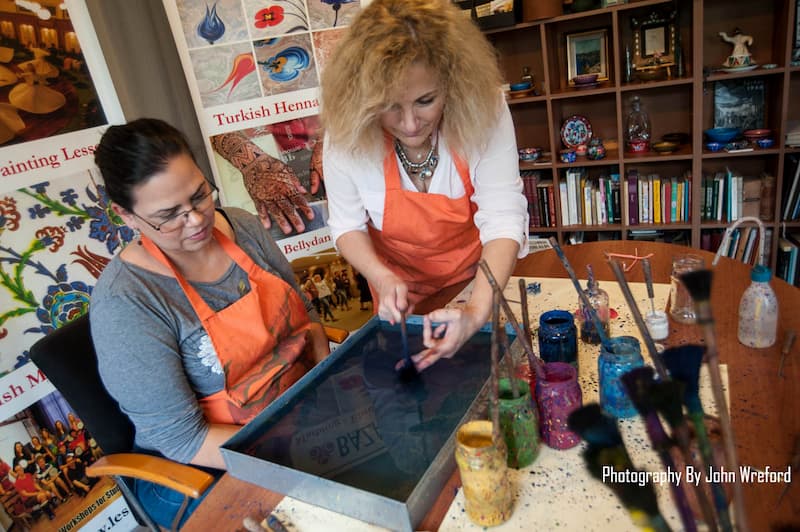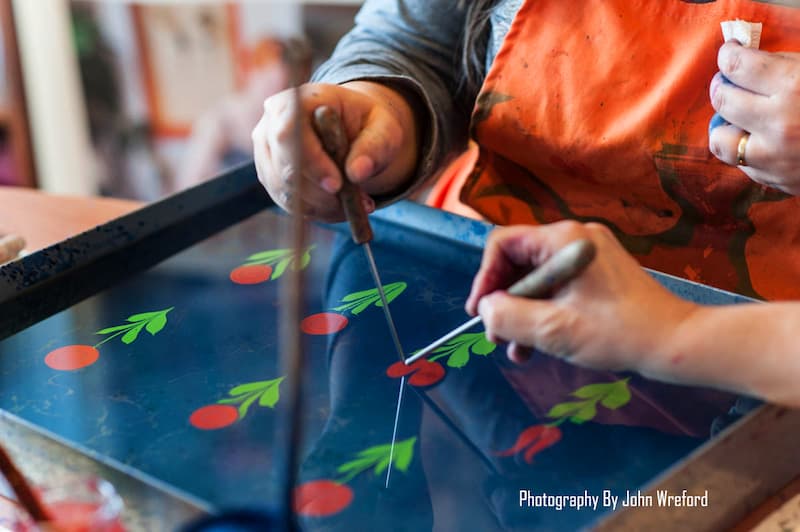Turkish Marbling - Ebru Workshop
Experiences
Ebru Workshop - Temporarily Not in Service
Experiences
Price Without Pass: €60
25% Discounted with Istanbul Tourist Pass® : €45
Your digital pass includes:
Free access to 100+ top Attractions
All digital, Show&Go easy Access
Saving guarantee after purchase
Huge savings up to 80%
Starting from just €29
Cancel anytime!
Turkish Marbling - Ebru Art! Discovering a new way to explore Turkish culture.
Ebru is the traditional skill of making colorful patterns by sprinkling and brushing colors on oily water and then transferring them to paper. Calligraphy and bookbinding are centuries-old traditions. In the 13th century, Central Asia's Ebru spread to Anatolia. Turkish calligraphers and painters improved methods during the Ottoman Empire.
Ebru is an art consisting of specific patterns and effects in the production utilizing colors containing a few drops of ox-gall (a natural acid helping the colors sprinkle on the gum) so prepared as to float upon preparation of condensed liquid with the use of kitre (a herbal gum) possessing certain properties to the colors ready for the purpose and which color floated and formed into patterns upon the surface of the liquid, are taken off by layin.
About The Turkish Marbling - Ebru Workshop
Mobile ticketing - Digital ticketing is available!
Duration – From 4:00PM to 6:00PM
Available Days - Every Day
Highlights
- Feeling the Turkish culture in your hands.
- Discovering a new way to explore Turkish culture.
- Having the experience of Turkish people.
About Ebru Workshop
Ebru is the traditional skill of making colorful patterns by sprinkling and brushing colors on oily water and then transferring them to paper. Calligraphy and bookbinding are centuries-old traditions. In the 13th century, Central Asia's Ebru spread to Anatolia. Turkish calligraphers and painters improved methods during the Ottoman Empire.
Ebru is an art consisting of specific patterns and effects in the production utilizing colors containing a few drops of ox-gall (a natural acid helping the colors sprinkle on the gum) so prepared as to float upon preparation of condensed liquid with the use of kitre (a herbal gum) possessing certain properties to the colors ready for the purpose and which color floated and formed into patterns upon the surface of the liquid, are taken off by layin.
Gelgit, tarakli, hatip, bülbül yuvasi, çiçekli developed over ages. Light green, red, and yellow is popular in Ebru. The motifs show their pattern. Flowers, greenery, decorative, and quarter moon are popular designs.
The element's bearers and practitioners are Ebru artists, apprentices, and those who practice Ebru as a hobby or vocation and consider it part of their culture, identity, and lifestyle. The element's practitioners are of diverse ages, genders, socioeconomic origins, and ethnicities.
Ebru artists are vital to its practice and transmission. Master and apprentice relationships are how they pass on their specific knowledge. All of Ebru's materials and equipment are manufactured by the artists, who are responsible for teaching information about element practice and equipment production.
Ebru is generally taught through casual, hands-on training. Ebru training emphasizes both skill and philosophy. The apprentice studies and imitates his/her master's work and helps apply Ebru. Identifying and producing training materials and equipment continues. After training introductions, apprentice applications commence. Beginners need two years to master Ebru.
More institutions, masters, NGOs, towns, and governorship offices are offering Ebru courses and workshops in response to expanding demand around the country. Young people and women love the workshops and classes.
The tradition shares optimism and develops community ties in accordance with individual and community ambitions. It encourages community members to participate in cultural and social activities.
In recent years, local administrations and colleges have offered more free courses and workshops on Ebru, attracting more women and youngsters. Ebru's large female membership strengthens women's social roles. Young practitioners increase their identity and cultural heritage by belonging to the element.
The aspect unites people around Ebru's art, fostering cordial friendships, easing communication, and eliminating cultural preconceptions. It encourages intercultural interaction and strengthens social relationships.
Geographies, cultures, people, and experiences improve Ebru. Each work of Ebru is unique because it combines water (a symbol of life), the dance of colors (a way to create a magnificent universe), and the artist's sentiments. Every drop of color becomes a masterpiece. Ebru's qualities allow artists to convey their innermost feelings, thoughts, and creativity through various approaches. The tradition showcases human potential by ornamenting books, calligraphy, glassworks, and presents.
In 2014, Turkey registered "Ebru: Turkish Art of Marbling" on UNESCO's Representative List of the Intangible Cultural Heritage of Humanity.
For this amazing experience and more, Buy Your Pass Now! Istanbul Tourist Pass® is here to make your Istanbul trip an unforgettable experience!
Hours & Meeting
All About Turkish Marbling - Ebru Workshop
Ebru is the traditional technique for creating vibrant patterns on paper by sprinkling and brushing colors into greasy water. Bookbinding and calligraphy are ancient crafts. The Ebru language from Central Asia reached Anatolia in the 13th century. During the Ottoman Empire, Turkish artists and calligraphers developed their techniques.
Ebru is a form of art that involves creating precise patterns and effects using colors that have been prepared with a few drops of ox-gall (a natural acid that helps the colors sprinkle on the gum) in order to float on condensed liquid using kitre (an herbal gum with special properties to the colors ready for the purpose). Once the colors have floated and formed patterns on the liquid's surface, they are removed by layin.
Over the years, gelgit, tarakli, hatip, bülbül yuvasi, and çiçekli emerged. Popular colors in Ebru are yellow, red, and light green. The motifs' pattern is obvious. Popular patterns include quarter moons, flowers, vegetation, and decorative elements.
The element's bearers and practitioners are Ebru artists, apprentices, and those who practice Ebru as a hobby or vocation and consider it part of their culture, identity, and lifestyle. The element's practitioners are of diverse ages, genders, socioeconomic origins, and ethnicities.
Ebru artists are vital to its practice and transmission. Master and apprentice relationships are how they pass on their specific knowledge. All of Ebru's materials and equipment are manufactured by the artists, who are responsible for teaching information about element practice and equipment production.
A Traditional Way of Learning Ebru
Ebru is generally taught through casual, hands-on training. Ebru training emphasizes both skill and philosophy. The apprentice studies and imitates his/her master's work and helps apply Ebru. Identifying and producing training materials and equipment continues. After training introductions, apprentice applications commence. Beginners need two years to master Ebru.
More institutions, masters, NGOs, towns, and governorship offices are offering Ebru courses and workshops in response to expanding demand around the country. Young people and women love the workshops and classes.
The tradition shares optimism and develops community ties in accordance with individual and community ambitions. It encourages community members to participate in cultural and social activities.
In recent years, local administrations and colleges have offered more free courses and workshops on Ebru, attracting more women and youngsters. Ebru's large female membership strengthens women's social roles. Young practitioners increase their identity and cultural heritage by belonging to the element.
The aspect unites people around Ebru's art, fostering cordial friendships, easing communication, and eliminating cultural preconceptions. It encourages intercultural interaction and strengthens social relationships.
Geographies, cultures, people, and experiences improve Ebru. Each work of Ebru is unique because it combines water (a symbol of life), the dance of colors (a way to create a magnificent universe), and the artist's sentiments. Every drop of color becomes a masterpiece. Ebru's qualities allow artists to convey their innermost feelings, thoughts, and creativity through various approaches. The tradition showcases human potential by ornamenting books, calligraphy, glassworks, and presents.
In 2014, Turkey registered "Ebru: Turkish Art of Marbling" on UNESCO's Representative List of the Intangible Cultural Heritage of Humanity.
Ebru, also known as Turkish marbling, is a traditional art form that
involves creating colorful patterns on paper or fabric using special
tools and techniques. With the Istanbul Tourist Pass®, visitors can have a
free Ebru Workshop experience and learn more about this unique art
form. During the workshop, participants will learn the basics of Ebru
marbling, including the techniques and supplies needed to create
beautiful patterns. They will also have the opportunity to try their
hand at creating their own Ebru designs on paper or fabric and take
their artwork home as a special souvenir. Whether you're an art lover or
simply looking to try something new, the Ebru Workshop experience is a
must-try activity for anyone visiting Istanbul.
Gallery
Advantages Of Istanbul Tourist Pass®
By having the Istanbul Tourist Pass®, you can visit more than 100+ attractions in Istanbul. You can save huge amount of time and money by not waiting in the long queues or paying fees at the entrances of the museums or for other facilities and activities. You can buy the Istanbul Tourist Pass®️ for 1, 2, 3, 4, 5, 7 or 10 days. So many attractions are available with Istanbul Tourist Pass®️ such as Topkapı Palace, Hagia Sophia, Dolmabahçe Palace, Sapanca Lake daily tour, Dinner on the Bosphorus, Istanbul Airport Shuttle etc. included in the pass. For more details and updated attractions available with the pass can be found on website.
Turkish Marbling - Ebru Workshop Frequently Asked Questions
Can I extend my time of activity by paying extra?
Do I need to bring anything special to attend Ebru session?
No, everything will be provided by the company.
Other Popular Attractions

4.8 out of 5 stars
Istanbul Tourist Pass® has an average rating of 4.8 /5 from 1441 reviews
Read all traveler reviews →








No, unfortunately, this activity is done only once with a group. After your work is done, you can book another session, but the extension of time is not possible.